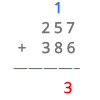In today’s post, we are going to learn about addition with regrouping.
Addition with regrouping consists of addition problems where the answer to the calculation is 10 or a larger number. For example, 6 + 7 = 13 is a regrouping addition problem.
The steps to solve regrouping addition problems are the following:
- If the column being added doesn’t have a carry-over (or if the number is lower than 10), write the answer under the column.
- If the column being added has a carry-over (or if the number is equal to or greater than 10), write the 1s-place numbers down under the bar and take note of the 10s-place number in the next column to add them later.
Let me show you an example of adding with regrouping. Try it with me!! 
Start by adding the 1s-place columns:
7 + 6 = 13
This number is greater than 10, so that means you need to write 3 under the 1s-place column and the 1 (the carry-over) above the next column. 
Now, you just add the next column, and don’t forget about the carry-over:
1 + 5 + 8 = 14
This number also has a carry-over. Write the 4 down in the column of the 10s-place and bring the 1 up to the next column.
Now, we just need to add the last column:
1 + 2 + 3 = 6
The only thing left is to write that number underneath in its appropriate column:
 So the final answer to this addition problem is 643. Did you get it right?
So the final answer to this addition problem is 643. Did you get it right?
Do you have any questions? You can use our comments to get some help.
I hope you liked learning how to add with regrouping and I also hope that you understand it well!
If you want to keep learning more elementary math, try Smartick for free.
Learn More:
- How to Add with Regrouping and Some Examples
- How to Add with and without Regrouping
- How to Solve Addition without Regrouping
- Learn How to Subtract without Regrouping
- Learn and Practice Vertical Adding







